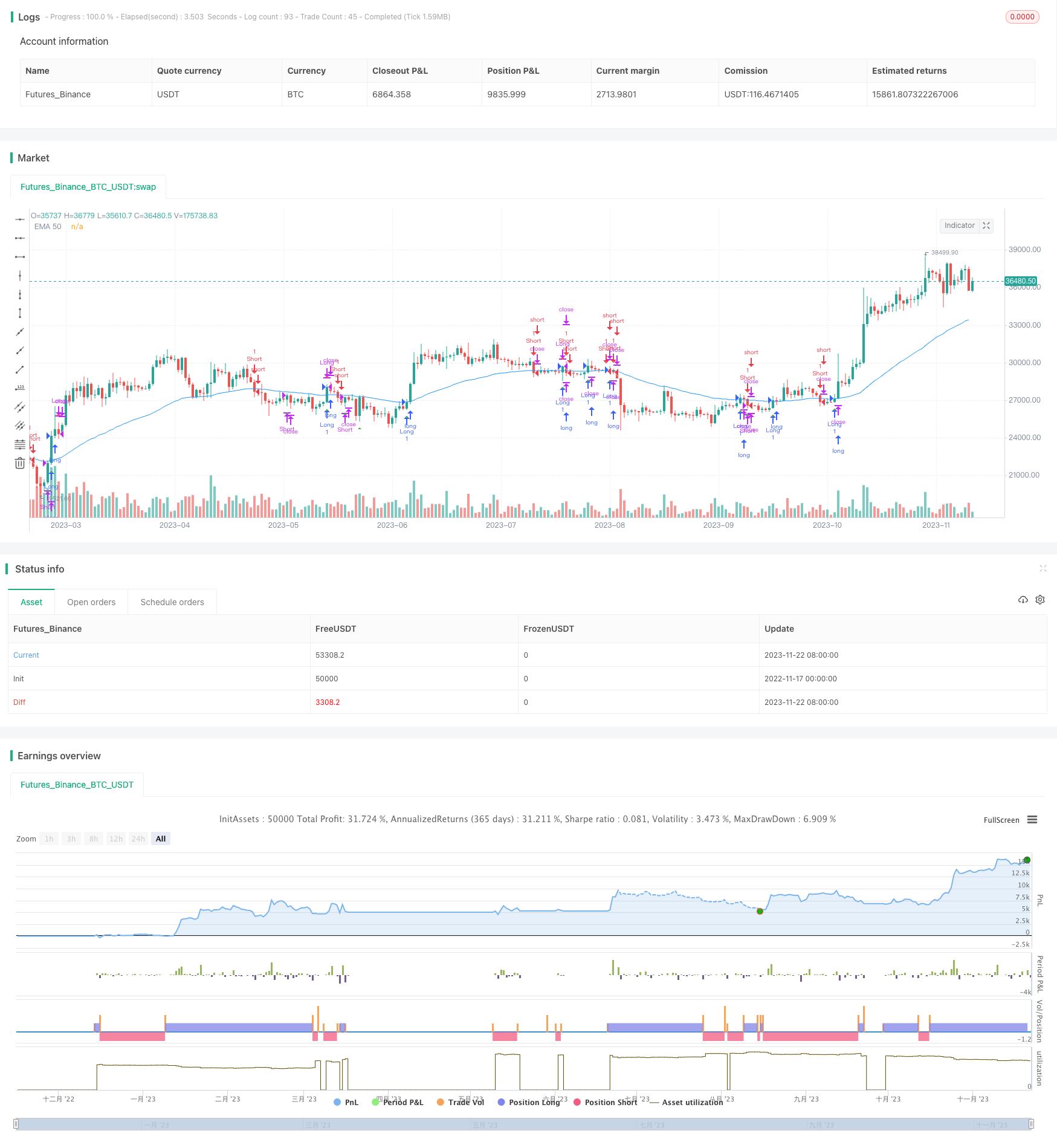EMA Crossover Strategy
Author: ChaoZhang, Date: 2023-11-24 13:49:45Tags:

Overview
This strategy is a trading strategy based on exponential moving average (EMA) crossover. It uses the 50-period EMA as the main technical indicator. When the price line crosses above the EMA from below, go long. When the price line crosses below the EMA from above, go short to profit.
Strategy Logic
The core idea is to use the 50-period EMA as a tool to judge the trend of prices. The EMA line can smooth the price data and remove short-term market noise to reflect longer term price trends. When the price line crosses above the EMA line from below, it indicates that prices are starting to rise which is a chance to go long. When the price line crosses below the EMA line from above, it indicates that prices are starting to fall which is an opportunity to go short.
Specifically, the strategy mainly includes the following aspects:
-
Input parameters: set EMA period to 50.
-
Indicator calculation: call ta.ema function to calculate 50-period EMA.
-
Entry conditions: a long signal is generated when price crosses above EMA, and a short signal is generated when price crosses below EMA.
-
Exit conditions: record the highest/lowest price when entering. Exit when price breaks that level later.
-
Visualization: plot EMA line and mark entry and exit points for long/short.
In this way, we can trade along the trend direction and timely stop loss when price starts to reverse.
Advantage Analysis
Compared with other indicators and strategies, the EMA crossover strategy has several significant advantages:
Simple and intuitive. The only core indicator is EMA which is easy to understand and operate. No messy complex indicators.
Flexible adjustment. The period of EMA can be adjusted very flexibly to suit different markets and products.
Catch the trend. EMA can effectively smooth price data and capture medium to long term trend changes.
Drawdown control. Use new highest/lowest price to stop loss which can control drawdowns very well.
Risks and Solutions
The strategy also has some risks, mainly including:
Trend missing. When prices fluctuate violently, EMA may not capture reversal points timely and miss trend change opportunities. Other indicators like Bollinger Bands can be combined for verification.
Premature stop loss. The stop loss point directly takes the highest/lowest price when signal appears. It may be too easy to reach and stop loss prematurely. Moving stop loss, widened stop loss range can be considered.
Parameter tuning. Unsuitable EMA period will lead to multiple incorrect signals. Parameters like EMA period need to be adjusted based on volatility, cycle etc.
Improvement Direction
The strategy has room for further improvement:
-
Combine with Bollinger Bands to filter signals and avoid incorrect EMA signals.
-
Improve the stop loss mechanism with trailing stop loss, swing stop loss etc to avoid premature exit.
-
Optimize EMA parameters based on different markets and trading instruments to find the most suitable periods.
-
Add auto parameter optimization module to find the optimum combination.
Conclusion
The strategy determines price trend based on EMA indicator and goes long on golden cross and goes short on death cross. The strategy is simple to operate and can trade along the trend direction with stop loss control. The strategy can be further optimized by combining more filter indicators, improving stop loss mechanisms etc. In general, the EMA crossover strategy is worth paying attention to and considering.
/*backtest
start: 2022-11-17 00:00:00
end: 2023-11-23 00:00:00
period: 1d
basePeriod: 1h
exchanges: [{"eid":"Futures_Binance","currency":"BTC_USDT"}]
*/
//@version=5
strategy("EMA 50 Crossover Strategy", shorttitle="EMA 50 xover", overlay=true)
// Input for EMA length
emaLength = input(50, title="EMA Length")
// Calculate EMA 50
ema50 = ta.ema(close, emaLength)
// Define conditions for long entry
longCondition = ta.crossover(close, ema50)
// Define conditions for short entry
shortCondition = ta.crossunder(close, ema50)
// Calculate the high of the signal candle for long entry
var float longSignalHigh = na
if (longCondition)
longSignalHigh := high
// Calculate the low of the signal candle for short entry
var float shortSignalLow = na
if (shortCondition)
shortSignalLow := low
// Long entry
plotshape(series=longCondition, title="Long Entry Signal", location=location.belowbar, color=color.green, style=shape.triangleup, size=size.small)
// Short entry
plotshape(series=shortCondition, title="Short Entry Signal", location=location.abovebar, color=color.red, style=shape.triangledown, size=size.small)
// Exit conditions
longExitCondition = ta.crossunder(close, longSignalHigh)
shortExitCondition = ta.crossover(close, shortSignalLow)
// Plot exit signals
plotshape(series=longExitCondition, title="Long Exit Signal", location=location.abovebar, color=color.red, style=shape.triangledown, size=size.small)
plotshape(series=shortExitCondition, title="Short Exit Signal", location=location.belowbar, color=color.green, style=shape.triangleup, size=size.small)
// Strategy entry and exit logic
strategy.entry("Long", strategy.long, when=longCondition)
strategy.entry("Short", strategy.short, when=shortCondition)
strategy.close("Long", when=longExitCondition)
strategy.close("Short", when=shortExitCondition)
// Plot EMA 50
plot(ema50, title="EMA 50", color=color.blue)
- Inverse Las Vegas Algorithmic Trading Strategy
- Solid Moving Average System Strategy
- Advanced Bollinger Band Moving Average Grid Trend Tracking Strategy
- Ichimoku Kinko Hyo indicator Balancing Trend Strategy
- Volume Price Indicator Balanced Trading Strategy
- Twisted SMA Adaptive Crossover Long Line Strategy
- Dual Moving Average Arbitrage Strategy
- Quantitative Investment Strategy Based on Monthly Buy Date
- Weighted Standard Deviation Trading Strategy
- Triple Moving Average Quantitative Trading Strategy
- Short-Term, Medium-Term and Long-Term EMA Crossover Trading Strategy
- Trend Following Strategy Based on Time Series Decomposition and Volume Weighted Bollinger Bands
- Detrended Price Oscillator Quantitative Trading Strategy
- Multi-indicator Trend Following Strategy
- CCI Dual Timeframe Trend Following Strategy
- T3-CCI Trend Tracking Strategy
- Cross Timeframe SuperTrend Breakout Strategy
- Momentum Reversal Moving Average Combination Strategy
- Dynamic Moving Average Retracement Martin Strategy
- Combo Momentum Reversal Dual-Rail Matching Strategy